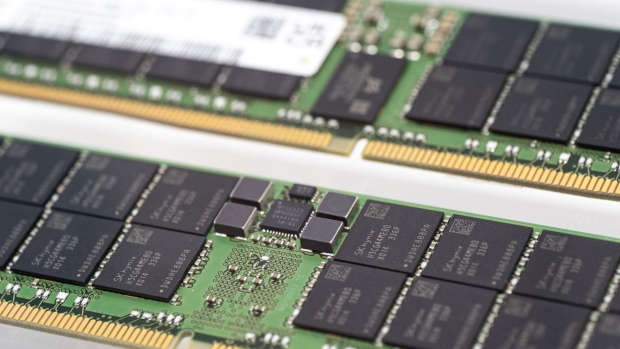Oct 25, 2023
SK Hynix Sales Decline Slows in Sign of Recovery for Chips
, Bloomberg News

(Bloomberg) -- SK Hynix Inc. reported a larger-than-expected loss despite moderating revenue declines, suggesting an uneven recovery for the global memory chip market. Shares tumbled the most in a year.
Its operating loss shrank to 1.79 trillion ($1.3 billion), compared with estimates of a 1.7 trillion won loss, according to analyst estimates compiled by Bloomberg. Its net loss of 2.2 trillion won was 42% wider than estimates.
The world’s No. 2 maker of memory chips and rival Samsung Electronics Co. have struggled through an industry downturn as demand for smartphones and personal computers wanes. Hynix shares dropped 5.9%, the most since last October.
“Most people were expecting operating loss to be as much as 1.3 trillion won so clearly from that perspective, there was a disappointment,” said Sanjeev Rana, an analyst with CLSA Securities Korea Ltd.
The South Korean company reported revenue that beat expectations, falling 17% from a year earlier to 9.07 trillion won, compared with expectations for 8.14 trillion won. That’s an improvement from a 47% slide in the previous three months.
But the wider-than-expected losses coupled with better-than-expected revenue raised concerns. That may reflect costs related to low fab utilization rates, Rana said.
SK Hynix’s stock has outperformed its larger rival this year, soaring 60% compared with about 21% for Samsung, even including Thursday’s decline. Samsung, which reported preliminary results earlier this month, revealed a more modest slide in profit than the previous quarter, which boosted shares.
SK Hynix has benefited from its deal to supply premium high-bandwidth memory, or HBM, to Nvidia Corp., whose artificial intelligence chips have been such a hit this year that its market valuation surged to $1 trillion.
SK Hynix said that it would boost capital expenditures for 2024 compared with this year, although the growth will be minimized to ensure efficiencies and avoid disrupting the market. It will prioritize spending for HBM and other strategic products.
Demand for HBM3 and HBM3E has exceeded capacity for next year, and the company is still getting requests for additional demand, SK Hynix officials said Thursday.
The company’s DRAM division returned to profit after two quarters of losses. It said average selling price rose 10% quarter over quarter, and chips prices are stabilizing after production cuts.
DRAM accounted for about two thirds of the company’s revenue for the quarter, while NAND chips bring in just over a quarter of the overall revenue.
“SK Hynix expects 2024 demand growth for both DRAM and NAND to be in the high teens,” Masahiro Wakasugi, senior industry analyst with Bloomberg Intelligence, wrote after the results.
Chipmakers have also been navigating rising political tensions between the US and China, leading to expanding export controls on semiconductors and related equipment. This month, the US granted SK Hynix and Samsung indefinite waivers to acquire the equipment they need to sustain and expand their giant chipmaking operations in China.
Read more: SK Hynix Says Won’t Agree to Western Digital-Kioxia Merger
Separately, SK Hynix, an indirect shareholder of Japan’s Kioxia Holdings Corp., said it has not given its consent to a merger of Kioxia and Western Digital Corp., introducing more uncertainty to a landmark US-Japanese deal years in the making.
SK Hynix “is not agreeing to the deal at this time in light of the overall impact on the value of the company’s investment” in Kioxia, Chief Financial Officer Kim Woohyun told analysts on a post-results call on Thursday. The company “will make a decision for the sake of all stakeholders, including not only the shareholders but also Kioxia.”
(Updates with analyst comment and share price from third paragraph.)
©2023 Bloomberg L.P.





